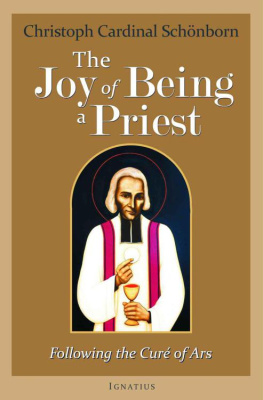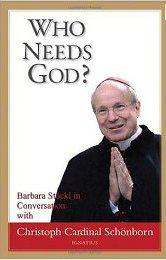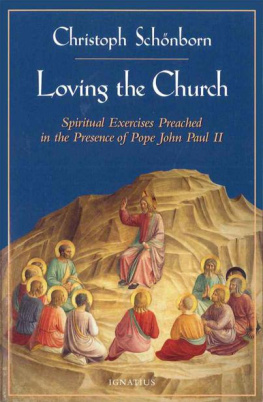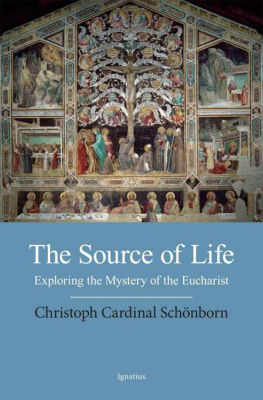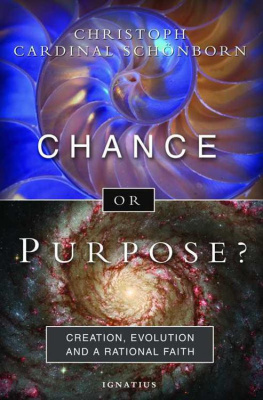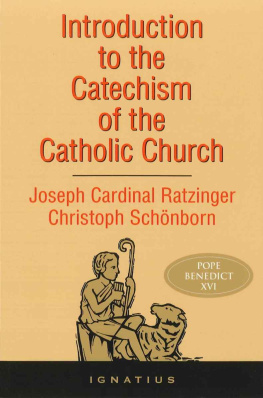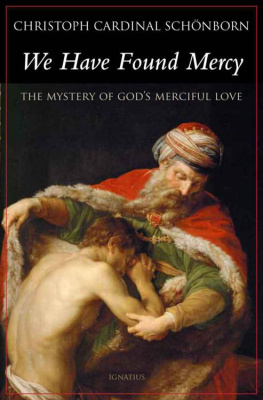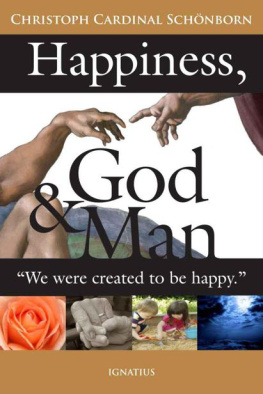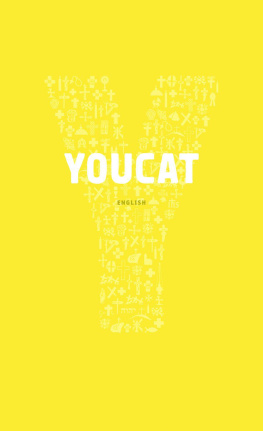MAN, THE IMAGE OF GOD
CHRISTOPH CARDINAL SCHNBORN
Man, the Image of God
The Creation of Man as Good News
TRANSLATED BY
HENRY TAYLOR AND MICHAEL J. MILLER
IGNATIUS PRESS SAN FRANCISCO
Original French edition:
LHomme et le Christ limage de Dieu:
La Cration de lhomme comme Bonne Nouvelle
2007 by ditions Parole et Silence, Paris
Foreword and Life in Full from German edition:
Der Mensch als Abbild Gottes
2008 by Sankt Ulrich Verlag GmbH, Augsburg
Cover art:
Detail from the lower register.
Byzantine icon (late 17th century)
Benaki Museum, Athens, Greece
Erich Lessing / Art Resource, New York
Cover design by Roxanne Mei Lum
2011 Ignatius Press, San Francisco
All rights reserved
ISBN 978-1-58617-420-0
Library of Congress Control Number 2011926374
Printed in the United States of America
Contents
PART TWO: MAN CREATED BY GOD:
THE BASIS OF MANS DIGNITY
PART FOUR: GOD WITH A HUMAN FACE
ART AND REAL PRESENCE
Foreword
No one has ever seen God (Jn 1:18). God is the inconceivable, incomprehensible, invisible, infinite One. And yet we read about Jesus, the Christ: The only-begotten Son, who is in the bosom of the Father, he has made him known (Jn 1:18). Jesus can say to Philip: He who has seen me has seen the Father (Jn 14:9).
Jesus is the image of the invisible God (Col 1:15). In him the invisible becomes visible. Jesus is the human face of God, his presence in human form. That is the core of the Christian message. Everything else follows from it: the Christian view of man, its understanding of society, culture, and art. Christ is really the midpoint, the Alpha, and the Omega. About him we read in Pauls letter: In him all things were created... in him all things hold together (Col 1:1617).
One of the most urgent tasks in communicating the faith today is to show the connections between the Christian concept of God and all the departments of personal and social life. Pope Benedict XVI is the outstanding teacher who tirelessly points out the relations between faith and reason and encourages us to give a thoughtful account of the reason for our hope (cf. 1 Pet 3:15).
Starting from Christ as the midpoint, the four essays collected in this volume attempt to give an account of the beauty and the coherence of our faith. The theandric mystery of Jesus is the key. In the Son of God who became man shines forth the glory of God in the human words and deeds of Jesus, in his life and death and in his Resurrection.
The second study, originally composed for the International Theological Commission, shows the consequences of faith in Christ for the unconditional dignity of every person. Here alone is the ultimate protection of human dignity guaranteed. History and current events show how quickly this support is lost if the uniqueness of the human person is no longer anchored in Gods unconditional Yes to every man.
The third essay, a lecture for the 2002 Hochschulwochen [University Weeks] in Salzburg, traces the theandric mystery in human life, indeed, in the phenomenon of life in general. Starting from wonder at the possibility of life in the universe, on our little planet, the question arises about what makes the life of us men something truly lived and alive. Augustines marvelous saying about the vita vere viva gives the answer: It is union with the One who can say about himself: I am the resurrection and the life (Jn 11:25).
The fourth essay returns again to the face of Christ. It is a meditation on the image of Christ and its significance for art. What George Steiner regarded as the hallmark of living artnamely, that it testifies to real presenceis indeed realized in Christ in a way that is unsurpassable.
In the title of this book, Man, the Image of God , man is used as a synonym for image of God. I understand this as a profession of faith in him who has bestowed the ultimate divine seal on all our dignity and beauty: in Jesus, the Christ, the Son of the living God! If this book fosters trust in him, friendship with him, and witness to him, then in my opinion there could be no better outcome.
+ Christoph Cardinal Schnborn
Kirchberg am Wechsel,
July 30, 2008
Feast of Saint Peter Chrysologus
PART ONE
Christ, the Loveliest of Men
Introduction
I start this meditation by looking at the feast of the Ascension. The angels say to those men of Galilee who cannot bring themselves to look away from the cloud that has hidden Jesus, carrying him away, This Jesus, who was taken up from you into heaven, will come in the same way as you saw him go into heaven (Acts 1:11).
More than thirty years ago, in the first edition of my book Gods Human Face: The Christ Icon , I remarked concerning what the angels said,
The prediction that he would return in the same way as they had seen him ascend implies the task for the disciples left behind, really the Church, to keep alive the remembrance of his face.... The icon is an expression of his living remembrance: it commemorates not merely a man from the distant past, but him who as man was glorified through suffering and the Cross, who is alive now and intercedes for us with the Father, and whose return to us has been promised. The icon is a connecting link between the Incarnation and the return, between the first and the last coming of the Lord. The icon not only perpetuates the memory of the Incarnation, it is also a constant reminder of the promised return of Christ. This is why the Eastern Church considers the icon of Christ an indispensable element of the profession of the Christian Faith. The Eastern Church sees the icon as a condensed version of the Creed.
The icon of Christ: for many Christians, the Eastern tradition of icons, their painting and their spirituality, has become something like a rallying point, a place where all Christians can meet. Icons are present more or less everywhere in the Church, both Eastern and Western. Their language, their symbolism, and their influence seem truly to touch the hearts of many of our contemporaries. People have often wondered why, in our own day, the art of the icon has now come to be seen as a special way of expressing the Christian faith.
There may be a fashionable side to this (the accusation some of the Orthodox make against Western Christians, under the impression that their Eastern tradition is wrongly used by Westerners). I think there is something deeper here. The sensus fidei recognizes in the Eastern tradition of icons a kind of canonical expression of our faith, an expression going beyond fashion and the cultural variations of Christian artistic language. Icons are not timeless; they do have stylistic variations, schools, cultural colorations; they are not static or immobile, the reproach often leveled against them. What is the secret of their attraction, then, the key to understanding their mystery? What is the reason for the great consistency in their expression?
I think that the ultimate reason for this is the Mystery of Christ himself, the Word Incarnate, God become man, who become circumscribable, as the saints who defended images, Saint Theodore the Studite and Saint Nicephorus of Constantinople, love to say. Over and beyond all cultural influences, any links with pre-Christian iconographic traditions, and any artistic variations, there is a common basis, one single source for iconic art: that is the mystery of the Holy Face of Jesus Christ. There is this one single face, there is this Jesus whom the apostles knew, with whom they ate and drank, whom they saw transfigured and saw abused: radiant with glory on Mount Tabor and scourged and crowned with thorns. It is that one unique face, that of Jesus the son of Mary, the Son of God, which stuck in Peters memory. It was the gaze of the One whom Peter had just denied and who was looking at him in a way that nothing on earth was able to erase from Peters memory or remove from his heart.
Next page

